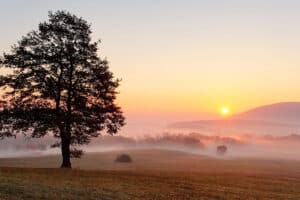“Value” is a word that everyone uses, but what does it mean and how is it measured? What makes some real estate valuable and some not?
What makes land, in particular, valuable to buyers? This question has more than one answer, and “location, location, location” is often in the chorus, not the spotlight.
Start with the idea of a merchantable asset, which is something that someone in his right mind will pay you a fair price for right now. (More technical definitions are available but don’t add anything useful.)
Some buyers look for — and value — properties that contain one or more merchantable assets that can be sold quickly to reduce the purchase cost. These might include an unwanted extra house, back acreage or mature timber ready to harvest. The buyer’s objective is to keep a core piece of the property and pay for as much of it as possible by selling unwanted, peripheral assets.
Retained assets that add value in a buyer’s calculation are items that can be leased (pasture and crop land, storage space, hunting rights, trails for horseback riding), rented (vacation homes, equipment), producing something for sale (crops) or used immediately by the new owner (house, outbuildings).
Property with all environmental rights retained and conveying should be considered a financial asset if it lends itself to a conservation easement. Property that bears a conservation easement should be discounted in value, because one or more important uses have been severed or limited.
The value of property adjacent to property with a conservation easement usually rises owing to the adjoining restrictions on development.
Most buyers value assets that are tangible keepers–a useable house, well-maintained fences, functioning utilities and other infrastructure. Specialized buyers will value specialized keeper assets, such as a year-round trout stream in the front yard or a developed horse operation.
Less tangible assets but no less important are “things” like compatible neighbors, quiet, privacy, an absence of boundary disputes and proximity to whatever most people like to be close to and away from what most people want to be out of sight, sound and smell.
Developers of rural land usually add value by packaging lots with natural and man-made amenities, such as recreational water (lake, river, stream), views, woods, clubhouse, trails and an appropriate level of infrastructure.
Buyers should pay more for land whose various assets can be used compatibly and simultaneously. Where using one asset precludes using others, value usually falls. A forest with an endangered species in residence is a high environmental asset, which, however, is likely to prohibit many other uses such as farming, timbering, road building and construction.
The more diverse a property’s assets and the more ways property can be used and enjoyed, the more market value and marketability it has, at least in my experience.
One buyer I know appraises property using what he calls, “opportunity analysis.”
As an investor, he values parcels that provide the most opportunities to do the most number of different activities, from making money to kicking back in a pretty spot and watching the breeze blow through the leaves.
Since assets can appreciate, depreciate and change over time, their future values need to be considered when figuring their current worth. The commercial value of many woodland tracts will increase as trees add girth and height, but overgrazed, eroding hillside pasture will deteriorate into a bigger economic and aesthetic liability. A good fishing stream can become polluted, turning an asset into a liability.
Property acquires value in terms of how it fits with a buyer’s multiple needs and wants. And the more “as is” the fit — that is, no additional investment required — the stronger the property’s appeal. When property meets the needs and wants of many buyers, particularly “as is,” its value rises as does its marketability.
Property has no value to a buyer whose needs it doesn’t fit, though it may be very valuable to a different buyer.
It’s generally more cost efficient to buy an existing asset (assuming it’s in good shape and does what you want it to do) than build it from scratch. I would value a 50-acre tract with a nice home site and view that’s accessed by a well-constructed mile-long road much higher than a comparable 50 acres with a marginally nicer home site and marginally nicer view that requires the construction of a one-mile road. When I was younger, I was more taken with views; at 63, I balance long views against the short view of the balance in my check book.
I’ve often seen buyers take their eyes off the ball. They develop a smart, reasonable set of search criteria, and then discard it when, for example, they’re shown a mint-julep house with two-story white columns on property that does not fit their needs. They saddle up on a runaway team of impulse and emotion.
It’s often easy to assume that all buyers value property in the same way. While many do, others don’t. Most buyers might pay a high price for a lake-front house that features a water view and private dock, but some won’t touch it owing to boat noise and lack of privacy, preferring instead an interior lot with water privileges. A timber investor would value 100 acres of scrub woods at no more than $500 an acre while a protectionist who plans to put a do-nothing-ever conservation easement on it and use it exclusively for bird habitat might pay $1,000.
Infrastructure in place — roads, water, sewerage, phone, electricity, high-speed Internet, cell service and so on — has more monetary value than it’s usually accorded. When infrastructure is done conscientiously, it makes everything else easier.
Calmness on a property’s periphery and in the general vicinity is worth paying for. Sellers rarely disclose nuisance, trespass and annoyance, which are often not obvious to a visiting buyer. Peace and quiet is worth a lot over time, though it may not be monetized by either seller or buyer.
Large acreages are subject to the same boundary disturbances as small ones. Buying peace and quiet is the value that buyers seek; don’t assume that buying bigger automatically inoculates you from commotion.
If a buyer is looking for an investment property or second home in the country, less travel time is a factor that translates into a willingness to pay a higher price. A closer place will be used more frequently and taken better care of than one more distant. Weekend use maxes out at three to four hours one-way driving for most of us.
Buyers discount the value of assets that are burdened with negatives, those running with an individual asset or with the property as a whole. A charming old house in bad shape is worth less to someone in his right mind than the same house in good shape; I know this opinion is considered a minority view in some circles. A nice place that’s too hot, too inaccessible or too near a zone of repugnance deserves to sell for less.
Too often, value is found in the fluttering heart of the beholder. A sharp pencil is useful in bringing a buyer with the pitty-pats back to his senses, even if it’s only applied to paper.
This content may not be used or reproduced in any manner whatsoever, in part or in whole, without written permission of LANDTHINK. Use of this content without permission is a violation of federal copyright law. The articles, posts, comments, opinions and information provided by LANDTHINK are for informational and research purposes only and DOES NOT substitute or coincide with the advice of an attorney, accountant, real estate broker or any other licensed real estate professional. LANDTHINK strongly advises visitors and readers to seek their own professional guidance and advice related to buying, investing in or selling real estate.









Have found your articles to be very helpful. I am planning timberland investment in the Camden, Arkansas, area. I know a good deal about pine and less about hardwood. But I am on a fast learning curve. I find South-central Arkansas to have a very strong site index with good loam-sand-clay mix and people who are serious about timber and less likely to attach inflated recreational values. Do you have any experience with that area. Also, forget about much of Northwest Louisiana as the Haynesville Shale makes it very messy for even those who only want surface rights on the land. God Bless and drop me a line. Once again, fantastic insights from your writings. Kurt Grussendorf.
OUTSTANDING ARTICLE AND TO THE POINT OF ALL SAVVY LAND INVESTORS/BUYERS
Rocky Rovedatti
Curtis,
You have the best overview of Land than any author I have followed. This article I will clip and add to those I send Buyers with Land inquiries..I also see advantage with stuborn sellers who think their Land is in the Garden of Eden…
Keep ’em coming…
Lou Jewell ALC
An area of land has value through its ability (if any) to call forth rent. When all sites are equally desirable (or undesirable), nobody owning one would want to charge rent for the right to occupy it, even though they are potentially useful, because all are of the same potential usefulness. But as soon as the natural resources are better in one place and/or the population density varies, making one region more desirable a place to live or work, there is social pressure to occupy and use or speculate in the value that has been created at that site. This creates the rent, which is relative to the least useful or marginal site. The value of any site is the “capitalized” rent, when the annual rate of interest on investment is taken as the numerical divisor of the rent. (The rate of investment is an annual percentage whilst the rent is cost per year, so numerically after division one gets a cost.) Rack-rent is when the scarcity of land or other social pressure raises the rent above this above described amount.